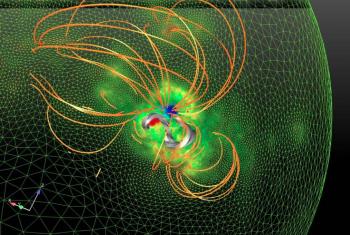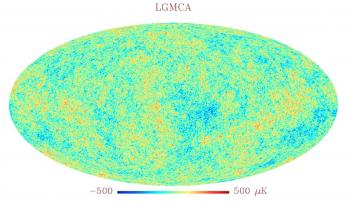News 2014
Researchers at the Center for Theoretical Physics (CNRS / Ecole Polytechnique) and Astrophysics Department-Laboratory AIM (CNRS / CEA / Université Paris Diderot) have identified a key phenomenon in the emergence of solar flares. Using satellite data and numerical modeling, the researchers were able to follow the evolution of the solar magnetic field in a specific area of the Sun that gave rise to a flare. Their calculations showed the formation of a "magnetic rope" [1] emerging from the internal atmosphere of the Sun and associated with the appearance of a sunspot. They show that this structure plays an important role in the onset of the flare. By modeling the complete evolution of the flare, this work opens the way to predicting solar storms that affect Earth. These results are on the front cover of Nature of 23 October 2014.
Using the latest data from the Planck and WMAP satellites, the laboratory CosmoStat (LCS) of CEA-IRFU just provides the most complete and accurate picture of the diffuse microwave background of the universe considered to be the primary light emitted at the beginning of the expansion. The new map of the diffuse background was built thanks to a new method of separating components called LGMCA particularly well suited to the separation of galactic foregrounds that blur the background image. Unlike previous results, the map restores the details of the diffuse background across the entire sky including the Galactic plane region of the sky where the estimate is particularly difficult. It is also more effective in reducing the defects introduced by the existence of hot gas in galaxy clusters. These results are in press in Astronomy & Astrophysics and were presented at the conference "Horizon of Statistics" on January 21, 2014 at the Institut Henri Poincare (Paris).
2014 has been a fruitful year for SVOM (Space-based multiband astronomical Variable Objects Monitor), a chinese and french space mission dedicated to the study of gamma-ray bursts. The decisions taken at the highest level, the governments in March and the respective space agencies in August, restart the project after a frozen period. As a direct result, two important meetings of the consortium (kick-off meeting) took place in September, one at CNES in Toulouse and the other at Shanghai. These meetings mainly based on technical aspects of the project are an important step towards the realization of the satellite payload of the mission which is scheduled to be launched in 2021. CEA-IRFU and its Astrophysics Department play a major role in this project in partnership with CNRS and under the overall responsibility of CNES.
For a more detailed account, see the French version.



